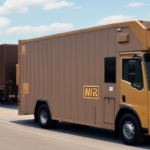Get the Best Rates for UPS Shipping
UPS is one of the most trusted shipping providers globally, offering reliable and efficient services for both domestic and international shipments. However, shipping costs can significantly impact your business, especially if you rely on UPS for regular shipments. In this comprehensive guide, we'll explore strategies to secure the best rates for UPS shipping, including tips for saving money, understanding UPS's rates and fees, comparing shipping rates with other carriers, negotiating better rates, and more.
Tips for Saving Money on UPS Shipping
The first step to obtaining the best rates for UPS shipping is to leverage available discounts and promotions:
- Discounts for Small Businesses: UPS offers a 20% discount for new customers and up to 50% off for large volume shippers. Ensure you inquire about these discounts when setting up your account.
- Promotional Offers: UPS frequently runs promotions, such as free shipping on orders over a certain amount or discounted rates for international shipments. Subscribe to UPS's email notifications to stay informed about current offers.
Additionally, utilizing UPS's online shipping platform can lead to significant savings:
- Online Shipping Tools: Creating and printing your own shipping labels online can save you up to 17% on shipping costs.
- UPS My Choice: This service allows you to choose specific delivery dates and times or redirect packages to UPS Access Point® locations for pick up, potentially reducing delivery costs.
Proper packaging is another crucial factor in minimizing shipping costs:
- Optimal Packaging: Use the right size and type of packaging to avoid additional fees for oversized or irregularly shaped packages.
- Free Packaging Options: UPS provides various free packaging materials, including boxes, envelopes, and tubes, designed specifically for their shipping services, ensuring your package is protected and reducing the risk of extra charges.
Finally, always compare rates and services from different shipping carriers to ensure you're getting the best deal. While UPS may offer competitive rates for certain services, other carriers might provide better rates for different types of shipments. Research and compare multiple carriers to find the best fit for your specific shipping needs.
Understanding UPS Shipping Rates and Fees
To accurately forecast your shipping costs, it's essential to comprehend how UPS calculates its rates and fees:
- Base Rates: UPS bases its rates on the weight and dimensions of your package, the distance it travels, and the level of service (e.g., Ground vs. Air).
- Additional Fees: Be aware of extra charges for services such as signature confirmation, Saturday delivery, or residential vs. commercial delivery. These fees should be factored into your overall shipping costs when comparing rates between carriers.
The type of item being shipped also influences UPS shipping rates:
- Special Handling: Items like hazardous materials or oversized packages may incur additional fees due to the need for special handling.
- Accurate Classification: Properly classify your shipments to avoid unexpected fees or delays.
Moreover, UPS offers various discounts and incentives for businesses that ship frequently or in large volumes:
- Volume Discounts: These can significantly lower your overall shipping costs.
- UPS Tools and Resources: Utilize tools like the UPS My Choice program and UPS Marketplace shipping platform to optimize your shipping processes and reduce costs.
For more detailed rate information, refer to the latest UPS Rate Guide.
How to Compare Shipping Rates Between UPS and Other Carriers
Determining if UPS is the best carrier for your shipping needs involves comparing rates and services with other carriers:
- Rate Comparison Tools: Tools like ShipStation allow you to compare rates from multiple carriers in one place, providing a clear overview of your options.
- Factors to Consider: Beyond price, consider transit times, package tracking capabilities, and customer service quality when selecting a carrier.
Another critical factor is the type of package you're shipping:
- Package Types: Some carriers offer better rates for specific package types, such as heavy or oversized items.
- Additional Fees: Be mindful of any extra charges like fuel surcharges or residential delivery fees that can impact your overall cost.
By thoroughly comparing rates and services from multiple carriers, you can ensure you're getting the best value for your shipping needs.
Negotiating Better Shipping Rates with UPS
If you're a large-volume shipper, negotiating better rates with UPS can lead to substantial savings:
- Contact Your Account Representative: Provide detailed information about your shipping history and future projections to negotiate based on volume, transit times, and other relevant factors.
- Waived or Reduced Fees: UPS may be willing to waive or reduce certain fees based on your shipment volume or shipping patterns.
Negotiating better shipping rates requires time and effort, including presenting comprehensive business and shipping data and committing to specific shipment volumes. However, the potential cost savings can significantly impact your bottom line.
The Benefits of Using UPS for Your Shipping Needs
While UPS may not always offer the lowest rates, it provides a wide range of services that can be highly beneficial for businesses:
- Variety of Delivery Options: UPS offers same-day, next-day, and 2-day shipping services, along with free package pickup and drop-off at select locations.
- Extensive Package Tracking: UPS's advanced tracking capabilities help reduce shipping errors and enhance customer satisfaction.
- Commitment to Sustainability: UPS has implemented eco-friendly initiatives, such as using alternative fuel vehicles and optimizing delivery routes to reduce emissions. More information can be found on their sustainability page.
- International Shipping: With services to over 220 countries and territories, UPS supports businesses operating globally, providing customs clearance assistance and a range of international shipping options tailored to specific business needs.
How to Qualify for Discounts on UPS Shipping
Besides general discounts and promotions, UPS offers additional discounts for businesses that meet specific criteria:
- Membership Discounts: Businesses that are members of certain organizations, such as the National Federation of Independent Businesses (NFIB), may qualify for special discounts.
- Customized Pricing: Businesses that ship a large volume of packages or have unique shipping needs can negotiate customized pricing structures with UPS.
To explore these opportunities, contact your [UPS account representative](https://www.shipscience.com/contact-ups) to discuss your eligibility for additional discounts.
Maximizing Your Savings with UPS's Flat Rate Boxes
If your business frequently ships small, heavy packages, UPS's Flat Rate Boxes can be a cost-effective solution:
- Fixed Pricing: With flat rate boxes, you pay a set rate based on the box size rather than the package weight, allowing you to predict shipping costs accurately.
- Ideal for Specific Items: This option is particularly beneficial for shipping items such as books, electronics, or other heavy products, offering savings compared to standard variable rates.
For more details on flat rate options, visit the UPS Flat Rate Box page.
The Most Cost-Effective Ways to Ship Packages with UPS
In addition to the previously mentioned tips, consider these strategies to further reduce UPS shipping costs:
- Consolidate Shipments: Combine multiple orders into a single shipment to take advantage of volume discounts.
- Choose Ground Shipping: Opt for ground shipping over air shipping when speed is not a priority, as it can significantly lower costs.
- Optimize Packaging Materials: Use lightweight packaging materials to reduce the overall weight and cost of shipments.
How to Avoid Additional Fees When Using UPS for Shipping
UPS may impose additional fees for services like address corrections, rerouting packages, or rescheduling deliveries. To avoid these extra charges:
- Verify Shipping Addresses: Double-check the accuracy of shipping addresses before dispatching packages.
- Provide Clear Instructions: Offer precise delivery instructions to minimize the need for rerouting or rescheduling.
- Utilize Free Package Pickup: Use UPS's free package pickup service to prevent delivery attempts and potential missed deliveries.
Tips for Accurately Calculating Your UPS Shipping Costs
Accurately calculating UPS shipping costs is crucial for budgeting and forecasting:
- Consider All Variables: Take into account the weight and dimensions of your package, the destination, and any additional fees.
- Use UPS's Online Shipping Tool: This tool can help determine the most cost-effective shipping options based on your package size and delivery needs.
For more information on calculating shipping costs, visit the UPS Shipping Calculator.
Common Mistakes to Avoid When Shipping with UPS
Avoiding common errors can help reduce shipping costs and prevent delays:
- Incorrect Package Dimensions and Weight: Always accurately weigh and measure your packages before shipping.
- Wrong Shipping Addresses: Ensure shipping addresses are correct to prevent rerouting fees.
- Improper Packaging: Use appropriate packaging materials to protect items and avoid additional fees for damaged or improperly packaged goods.
- Handling Fragile Items: Properly package fragile items to prevent damages and the associated costs.
How to Track Your UPS Shipments and Save Money
Effective shipment tracking can help identify potential delays or issues early, allowing you to take corrective actions:
- Monitor Shipment Progress: Use UPS's tracking capabilities to stay informed about your package's status and make timely decisions.
- Redirect Shipments: If necessary, redirect packages to alternate delivery locations to avoid additional costs.
- Notification Services: Subscribe to UPS's notification services to receive updates on the status of your packages and any potential issues.
Explore UPS's tracking features on their tracking page.
The Pros and Cons of Using UPS vs. Other Carriers
While UPS is a leading shipping carrier, it's important to weigh its advantages and disadvantages against other options like FedEx and USPS:
- UPS: Known for reliability, extensive tracking, and a wide range of services, but may not always offer the lowest rates.
- FedEx: Offers competitive rates and excellent international shipping options, but might have higher costs for certain services.
- USPS: Often the most affordable option for small and lightweight packages, but may lack the same level of tracking and speed as UPS and FedEx.
Consider factors such as price, reliability, service levels, and specific shipping needs when choosing the best carrier for your business.
The Future of Shipping: What Changes You Should Expect from UPS
The shipping industry is continuously evolving with advancements in technology and sustainability initiatives. UPS is at the forefront of these changes, incorporating new technologies and practices to enhance their services:
- Innovative Technologies: UPS is exploring the use of drones and autonomous vehicles for deliveries, aiming to increase efficiency and reduce delivery times.
- Sustainable Practices: The company has invested in electric and hybrid delivery vehicles and optimized delivery routes to minimize environmental impact.
- Enhanced Customer Experience: UPS is developing new tools and services to meet changing customer needs, such as improved tracking systems and flexible delivery options.
As UPS continues to innovate, businesses can expect new opportunities to save on shipping costs and improve overall shipping operations.
In conclusion, mastering UPS shipping rates involves a combination of leveraging discounts, optimizing shipping practices, understanding UPS's pricing structure, and staying informed about industry trends. By implementing these strategies, you can minimize shipping costs, enhance efficiency, and ultimately achieve better business outcomes and increased customer satisfaction.




















